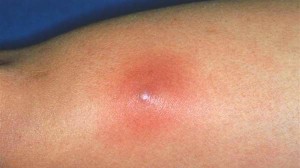Boils and Carbuncles Overview
Boils and carbuncles are painful, pus-filled bumps that form under your skin when bacteria infect and inflame one or more of your hair follicles.
Boils (furuncles) usually start as red, tender lumps. The lumps quickly fill with pus, growing larger and more painful until they rupture and drain. A carbuncle is a cluster of boils that form a connected area of infection under the skin.
You can usually care for a single boil at home, but don’t attempt to prick or squeeze it that may spread the infection. Call your doctor if a boil or carbuncle is extremely painful, lasts longer than two weeks or occurs with a fever.
Risk Factors of Boils and Carbuncles
Older age, obesity, poor hygiene, and poor overall health are associated with carbuncles. Other risk factors for carbuncles include:
- Chronic skin conditions, which damage the skin’s protective barrier
- Diabetes
- Kidney disease
- Liver disease
- Any condition or treatment that weakens the immune system
Carbuncles also can occur in otherwise healthy, fit, younger people, especially those who live together in group settings such as college dorms and share items such as bed linens, towels, or clothing. In addition, people of any age can develop carbuncles from irritations or abrasions to the skin surface caused by tight clothing, shaving, or insect bites, especially in body areas with heavy perspiration.
Symptoms of Boils and Carbuncles
A boil looks like a red, swollen, painful bump under the skin. As the infection gets worse, a whitish tip, also called a point or head, can appear at the center of the boil. This tip is usually the area from which the boil’s pus will drain. A carbuncle looks like a cluster of interconnected boils.
Whenever you have a boil or a carbuncle, you also can have a fever and feel generally sick. A fever is more likely with a carbuncle than with a single boil.
What Causes Boils and Carbuncles?
A Boils and Carbuncles usually develops when Staphylococcus aureus (staph) bacteria enter your hair follicles. Scrapes and other broken skin make it easy for bacteria to enter your body and cause an infection. This can result in a number of fluid- and pus-filled boils containing dead tissue.
The moist parts of your body are particularly susceptible. Bacteria thrive in these areas particularly in the nose, mouth, groin, thighs, and armpits.
How is a Boils and Carbuncles be Treated?
A Boils and Carbuncles should never be squeezed or pricked with a pin or sharp object to release the pus and fluid. This can spread the infection to other parts of the skin.
If left alone, a boil will break and drain on its own over time; in certain cases, a doctor may need to cut into the skin to drain the pus. Once the fluid and pus drains from the boil or carbuncle, it will heal. The doctor may also prescribe antibiotics if there is a serious infection.
If you have a boil, you can do the following:
- Apply warm, moist compresses (such as a damp washcloth) several times a day. This can speed healing and relieve some of the pain and pressure caused by the boil. A separate washcloth (and towel) should be used.
- See a health care provider if the boil persists or comes back, or if it is located on the spine or on your face.
- If you have a fever or other serious symptoms with the boil, see your doctor. Patients who have diabetes or who have a condition that affects the immune system should see a doctor for the treatment of the boil.
Who is affected by Boils and Carbuncles?
Boils are relatively common in teenagers and young adults, especially in males. Young males living in overcrowded and possibly unhygienic conditions are particularly at risk.
Carbuncles are less common and tend to occur mostly in middle-aged or older men who are in poor health because of a pre-existing health condition, such as diabetes.
Complications of Boils and Carbuncles
- Boils and carbuncles can leave scars.
- Surrounding cellulitis or bacteraemia may develop if furunculosis or carbuncles extend.
- Cavernous sinus thrombosis can complicate boils or carbuncles on the face, but this is rare.
- Metastatic infection is rare, but can include osteomyelitis, acute endocarditis or brain abscess. Septicaemia is a very rare complication of both furuncles and carbuncles.












